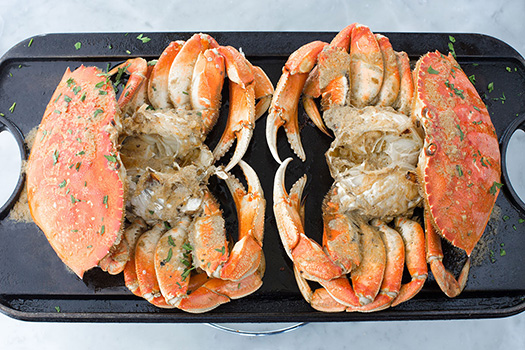About the Crab at The Stinking Rose – Beverly Hills

We buy only Dungeness crab that weighs at least two plus pounds (for those meaty legs) and is harvested from the nearby Pacific Ocean. The whole crab is roasted and drizzled with our crab butter sauce.
It's Addictive!
San Francisco's Fisherman's Wharf is a landing spot for many kinds of seafoods, but a glance at the big sign overlooking the parking lot (or at the smaller signs posted around the city pointing the way to the wharf) gives a clue to which is most important. Both signs feature the distinctive shape of Dungeness crab, one of the treasures of the West Coast fish market, and the symbol of the Golden Gate fishing industry.
Most of the year, but especially in winter, the air around the wharf carries the scent of crabs boiling in large outdoor pots, to be sold in walk-away crab cocktails, or taken home to serve as simple cracked crab. Inside the nearby restaurants, they may be combined with other seafoods in a thick tomato-based stew called cioppino, or as chunks of crab meat heaped on top of a salad with Louis dressing.
Native to coastal waters from southern California to the Aleutians, Dungeness crab (Cancer magister) is the main commercial crab species south of Alaska, with important landings in nearly every fishing port north of Santa Barbara. It's a fairly large species, weighing about a pound and a quarter apiece in the minimum legal size (6-1/4 inches across the carapace, or upper shell) and running up to about 3 pounds. Most of the catch is consumed close to home, but some gets shipped to other parts of the country both fresh and frozen.
Around San Francisco, the season usually begins in November, and cracked crab is as much a tradition at some Bay Area Thanksgiving tables as turkey.
The common name of Dungeness crab comes from the town of the same name on Washington's Olympic Peninsula, which in turn was named after a point on the English coast near the strait of Dover. Perhaps coincidentally, the waters off southern England are home to a close cousin of Dungeness crab, the European common or edible crab (C. pagurus).




